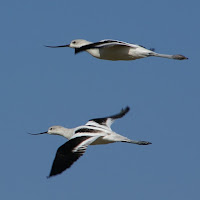AMERICAN AVOCET
AMERICAN AVOCET – (Recurvirostra americana) – (See images below)
DESCRIPTION: The American avocet is a large shorebird with a long, thin and upward-curved black bill and long grey legs. In the summer the adults have a burnt orange head and neck, white under parts, and black and white vertical bars on the back and wings. In the winter, the head is grey and the neck is white. The length is approximately 45 cm (17 inches).
VOICE: https://www.xeno-canto.org/species/Recurvirostra-americana
NAME: The English name ‘Avocet’ stems from ‘avis’ a bird. The Latin genus name ‘Recurvirostra’ means ‘upward-curved bill’.
HABITAT: Shallow saltwater or freshwater such as in ponds, tidal flats, rice fields, mud flats.
DIET: This bird sweeps its bill from side to side in shallow water in search of invertebrate prey.
NESTING: American avocets breed in colonies near or on the water. The nest is built on the ground in vegetation. Around three eggs are laid, which are incubated by both parents. Chicks are able to feed themselves from birth.
When nesting, these avocets are highly protective of their nests, and might even physically attack predatory birds. American avocets practice intra and inter-species brood parasitism. They will also raise young from other species, such as Terns or the related Stilt.
DISTRIBUTION: The breeding range of this bird encompasses southern Alberta and Saskatchewan in Canada, and the western half of the USA. It winters in southeast USA and Mexico for the most part, frequently along the coasts. Some vagrants even ended up in Hawaii. (See note below for information on bird vagrancy.)
ON PEI: Just like the Black-necked Stilt with which it shares the same family, the American avocet has only been observed ‘accidentally’ on Prince Edward Island.
CONSERVATION: The species is not at risk and its population appears stable.
Vagrancy: In biology this means an animal going way outside its normal range. For birds, this can happen when there are storms and they get blown off course. On other times, the bird simply wanders in a different direction than usual. Here’s an article about vagrancy in birds.
SIMILAR SPECIES: Marbled Godwit, Black-necked Stilt
REFERENCES: https://www.borealbirds.org/bird/american-avocet
https://www.allaboutbirds.org/guide/American_Avocet/id
http://birdweb.org/birdweb/bird/american_avocet
https://www.audubon.org/field-guide/bird/american-avocet
https://en.wikipedia.org/wiki/American_avocet
http://www.nhptv.org/natureworks/avocet.htm (New Hampshire PBS)
DESCRIPTION: The American avocet is a large shorebird with a long, thin and upward-curved black bill and long grey legs. In the summer the adults have a burnt orange head and neck, white under parts, and black and white vertical bars on the back and wings. In the winter, the head is grey and the neck is white. The length is approximately 45 cm (17 inches).
VOICE: https://www.xeno-canto.org/species/Recurvirostra-americana
NAME: The English name ‘Avocet’ stems from ‘avis’ a bird. The Latin genus name ‘Recurvirostra’ means ‘upward-curved bill’.
HABITAT: Shallow saltwater or freshwater such as in ponds, tidal flats, rice fields, mud flats.
DIET: This bird sweeps its bill from side to side in shallow water in search of invertebrate prey.
NESTING: American avocets breed in colonies near or on the water. The nest is built on the ground in vegetation. Around three eggs are laid, which are incubated by both parents. Chicks are able to feed themselves from birth.
When nesting, these avocets are highly protective of their nests, and might even physically attack predatory birds. American avocets practice intra and inter-species brood parasitism. They will also raise young from other species, such as Terns or the related Stilt.
DISTRIBUTION: The breeding range of this bird encompasses southern Alberta and Saskatchewan in Canada, and the western half of the USA. It winters in southeast USA and Mexico for the most part, frequently along the coasts. Some vagrants even ended up in Hawaii. (See note below for information on bird vagrancy.)
ON PEI: Just like the Black-necked Stilt with which it shares the same family, the American avocet has only been observed ‘accidentally’ on Prince Edward Island.
CONSERVATION: The species is not at risk and its population appears stable.
Vagrancy: In biology this means an animal going way outside its normal range. For birds, this can happen when there are storms and they get blown off course. On other times, the bird simply wanders in a different direction than usual. Here’s an article about vagrancy in birds.
SIMILAR SPECIES: Marbled Godwit, Black-necked Stilt
REFERENCES: https://www.borealbirds.org/bird/american-avocet
https://www.allaboutbirds.org/guide/American_Avocet/id
http://birdweb.org/birdweb/bird/american_avocet
https://www.audubon.org/field-guide/bird/american-avocet
https://en.wikipedia.org/wiki/American_avocet
http://www.nhptv.org/natureworks/avocet.htm (New Hampshire PBS)
 |
| American Avocet, breeding plumage Fish and Wildlife Service |
 |
| American avocets, winter plumage Palo Alto Baylands Nature Preserve Photo by David Baron |